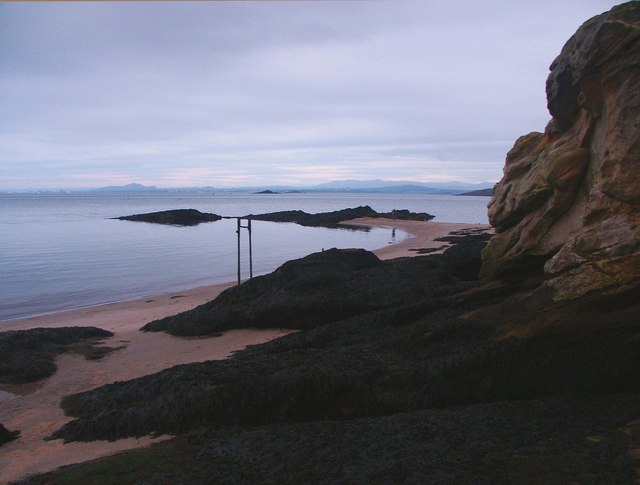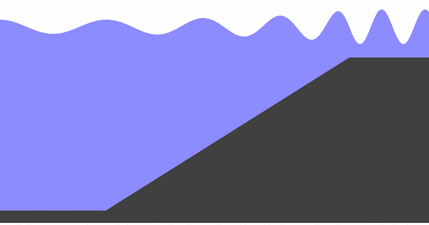Waves are continuously subjected to transformations due to their interaction with the sea bottom, the shoreline and forms that are encountered while travelling. These transformations are particularly important for what concerns the action of wave on structures and the shaping of the shoreline. In what follows we will consider four types of transformation:
- Refraction;
- Diffraction;
- Shoaling;
- Friction over the sea bottom.
1. Refraction
Refraction is the change in direction of a wave caused by its change of speed and wavelength that is due to variation of the properties of the transmission medium. For sea waves, the refraction is caused by slower propagation in shallow water than in deep water. Therefore, when the wave direction is not perpendicular to the shoreline, the wave crest enters in shallower water at different times. The part of the crest first approaching shallow water slows its velocity down and therefore the wave fronts tend to become aligned with the shoreline. An example of wave refraction is given in Figure 1.
 Figure 1. Wave refraction in Chapmans Pool. By Nigel Chadwick, CC BY-SA 2.0, https://commons.wikimedia.org/w/index.php?curid=13443120
Figure 1. Wave refraction in Chapmans Pool. By Nigel Chadwick, CC BY-SA 2.0, https://commons.wikimedia.org/w/index.php?curid=13443120
Wave refraction also occurs around a circular island. The wave approaching from one direction will wrap around the island so the wave crest will approach the beach close to parallel on all sides of the island. Behind the island the wave fronts meet and cause the deposition of the longshore sediment transport. This phenomenon is shown in Figure 2.
 Figure 2. Wave refraction originates the deposition of sand where the waves meet around the island. By Simon Johnston [CC BY-SA 2.0 (http://creativecommons.org/licenses/by-sa/2.0)], via Wikimedia Commons
Figure 2. Wave refraction originates the deposition of sand where the waves meet around the island. By Simon Johnston [CC BY-SA 2.0 (http://creativecommons.org/licenses/by-sa/2.0)], via Wikimedia Commons
2. Diffraction
Diffraction occurs when a wave meets sheltering shapes like an island or a breakwater. Waves tend to propagate into the lee zone behind the obstacle by energy propagation along the wave crest. Diffraction is defined as the bending of wave around the corners or aperture of the obstacle. Diffraction arises because of the way in which waves propagate. The propagation of a wave can be visualized by considering every particle of the transmitted medium on a wavefront as a point source for a secondary spherical wave. The wave displacement at any subsequent point is the sum of these superimposing waves. When waves are added together, their sum is determined by the relative phases as well as the amplitudes of the individual waves. The movement of the wave around the corner is due to the secondary wave.
Therefore, diffraction involves a change in direction of waves. The longer the wavelength, the more significant the diffraction is. When the wavelength of the waves is shorter than the size of the obstacle along the wave direction of propagation, no noticeable diffraction occurs.A video explaining wave diffraction can be found here.
3. Shoaling
Shoaling is the deformation of the waves, which starts when the water depth becomes less than about half the wavelength. The shoaling causes a reduction in the wave propagation velocity as well as a decrease of the wavelength, so that the frequency is preserved. Shoaling can be explained basing on the principle of conservation of energy flux. In fact, a decrease in wave velocity, in order to preserve the energy flux, must be compensated by an increase of the energy density. Shoaling is shown in Figure 3.
 Figure 3. Conservation of energy flux in decreasing sea depth nearshore originates process of shoaling, which takes place in the so-called "shoaling zone". By Régis Lachaume - own artwork, CC BY-SA 3.0, https://commons.wikimedia.org/w/index.php?curid=3799016
Figure 3. Conservation of energy flux in decreasing sea depth nearshore originates process of shoaling, which takes place in the so-called "shoaling zone". By Régis Lachaume - own artwork, CC BY-SA 3.0, https://commons.wikimedia.org/w/index.php?curid=3799016
4. Bottom friction
Bottom friction causes energy dissipation and thereby wave height reduction as the water depth becomes more and more shallow. Friction is of special importance over large areas with shallow water. The reduction of wave height may amount to as much as 30 per cent on very flat beaches for wave periods commonly occurring in the ocean.
Last modified on February 27, 2019
 Figure 1. Wave refraction in Chapmans Pool. By Nigel Chadwick, CC BY-SA 2.0, https://commons.wikimedia.org/w/index.php?curid=13443120
Figure 1. Wave refraction in Chapmans Pool. By Nigel Chadwick, CC BY-SA 2.0, https://commons.wikimedia.org/w/index.php?curid=13443120 Figure 2. Wave refraction originates the deposition of sand where the waves meet around the island. By Simon Johnston [CC BY-SA 2.0 (http://creativecommons.org/licenses/by-sa/2.0)], via Wikimedia Commons
Figure 2. Wave refraction originates the deposition of sand where the waves meet around the island. By Simon Johnston [CC BY-SA 2.0 (http://creativecommons.org/licenses/by-sa/2.0)], via Wikimedia Commons Figure 3. Conservation of energy flux in decreasing sea depth nearshore originates process of shoaling, which takes place in the so-called "shoaling zone". By Régis Lachaume - own artwork, CC BY-SA 3.0, https://commons.wikimedia.org/w/index.php?curid=3799016
Figure 3. Conservation of energy flux in decreasing sea depth nearshore originates process of shoaling, which takes place in the so-called "shoaling zone". By Régis Lachaume - own artwork, CC BY-SA 3.0, https://commons.wikimedia.org/w/index.php?curid=3799016